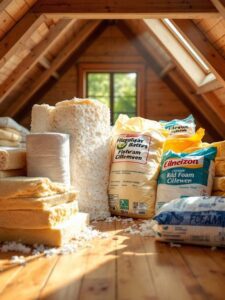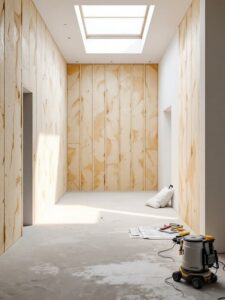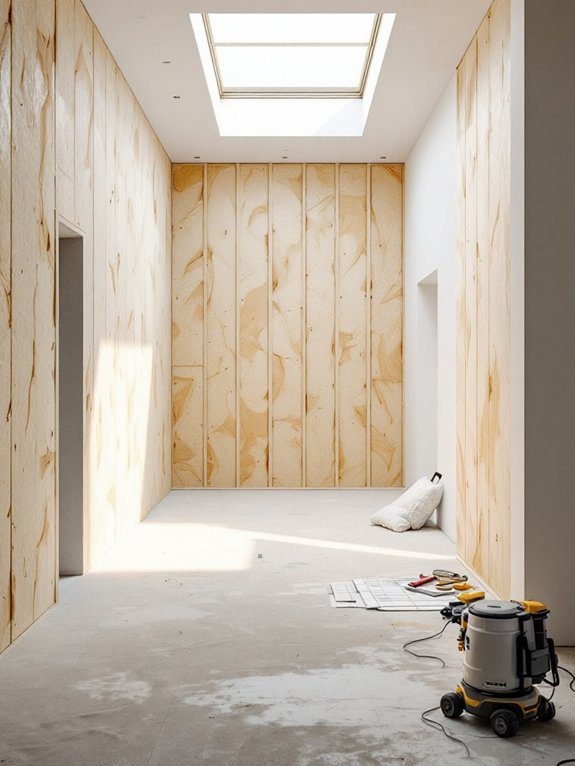You can get free loft insulation through UK government grants in 2025 if your household income is under £31,000 and your home has an EPC rating between D and G. The Great British Insulation Scheme (GBIS) and ECO4 program offer full coverage for properties with less than 100mm of existing insulation. If you receive Universal Credit, Pension Credit, or other qualifying benefits, you’re likely eligible. Understanding the specific requirements will help maximize your chances of approval.
Key Takeaways
- Government grants like ECO4 and GBIS can fully cover loft insulation costs for eligible households with EPC ratings D-G in 2025.
- Households earning under £31,000 annually or receiving benefits like Universal Credit qualify for free loft insulation through government schemes.
- Properties with less than 100mm of existing insulation are prioritized for full grant funding in current government initiatives.
- The £1 billion GBIS scheme aims to retrofit 300,000 homes until March 2026, offering free insulation to qualifying properties.
- Homeowners in Council Tax bands A-D in England (up to E in Scotland/Wales) can access full funding for various insulation types.
What Makes Loft Insulation Grants Worth Considering
While energy costs continue to rise across the UK, government grants for loft insulation offer a compelling solution for homeowners seeking to reduce their expenses.
You’ll find several loft insulation advantages that make these financial incentives particularly attractive in today’s economic climate. Installing proper loft insulation can save you hundreds of pounds annually on your energy bills, while simultaneously reducing your home’s carbon footprint.
Loft insulation offers dual benefits: significant yearly energy savings and a smaller carbon footprint, making it a smart investment for homeowners.
The installation process typically takes less than a day, making it a convenient home improvement option. Through schemes like ECO and GBIS, you’re able to access government support, particularly if you’re receiving specific benefits or have a lower-income household. With lasting forty years, quality loft insulation provides decades of energy-saving benefits when installed correctly.
For optimal performance, insulation should be upgraded to 270mm thickness in homes where current coverage is insufficient.
Additionally, your well-insulated home will maintain more comfortable temperatures year-round, potentially increasing its market value while contributing to the UK’s broader sustainability goals.
Understanding the New 2025 Government Schemes
As the UK government rolls out new energy efficiency initiatives for 2025, two major schemes stand at the forefront: the Great British Insulation Scheme (GBIS) and ECO4.
These programs focus on homes with EPC ratings D-G, making them accessible to properties most in need of energy improvements.
You’ll find these programs are set to continue until March 2026, with GBIS allocating £1 billion to retrofit 300,000 homes.
Properties with minimal loft insulation currently installed are particularly encouraged to apply.
The 2025 initiatives bring exciting developments, including the launch of the Warm Home Plan in spring 2025.
You’re looking at enhanced future funding opportunities, with programs like the Boiler Upgrade Scheme offering up to £7,500 for heat pump installations.
These schemes work alongside existing support like the Warm Home Discount Scheme, ensuring you’ve got thorough coverage for your energy efficiency needs.
If your household income is below £31,000 or you’re receiving benefits, you’re likely eligible to participate in these transformative programs.
Key Eligibility Requirements for Insulation Support
Since qualifying for loft insulation grants depends on multiple criteria, you’ll need to meet specific income and property requirements.
If your household receives Universal Credit, Pension Credit, or other qualifying benefits, or if your annual income falls below £31,000, you’re likely eligible for support through schemes like GBIS and ECO4. These programs can provide full grant coverage for eligible households.
Your property conditions also play a significant role. Your home should have insufficient loft insulation (less than 100mm) or outdated insulation needing replacement. Installing proper insulation to the recommended 270mm depth can maximize your home’s heat retention.
Properties with EPC ratings of D or below typically qualify, with some schemes specifically targeting homes rated E, F, or G.
Council Tax bands matter too – if you’re in bands A to D in England (up to E in Scotland and Wales), you’ll meet another key eligibility criterion.
All installations must be completed by approved professionals to PAS standards.
Types of Loft Insulation Covered by Grants
Four main types of loft insulation qualify for government grants, with blanket (roll) insulation being the most commonly approved option.
You’ll find this insulation material fits perfectly between your loft’s joists, making it a straightforward choice for most homes.
Loose fill and blown fiber installation methods offer excellent alternatives, especially if your loft has irregular spaces or hard-to-reach areas that need thorough coverage.
Loose fill and blown insulation excel at reaching every nook and cranny, ensuring complete coverage in challenging loft spaces.
While sheet insulation isn’t as commonly used, it’s still grant-eligible for specific applications where larger surface areas need covering.
Homes with an EPC rating D or lower may be eligible for free installation through the Great British Insulation Scheme.
To qualify for support, your current insulation must typically be less than 100mm thick, as grants aim to help you achieve the recommended 270mm depth.
Professional installers will assess your space and recommend the most suitable option for your home. These improvements can lead to significant annual savings of between £330 and £590 on your energy bills.
Step-by-Step Application Guide for Insulation Funding
When applying for loft insulation funding, you’ll need to follow a structured process that starts with checking your eligibility through online assessment tools.
Different funding sources, including the GBIS and ECO4 schemes, have varying application timelines and requirements you’ll need to navigate.
- Contact your local authority or energy supplier to identify available grants and confirm your household’s eligibility based on income level (under £31,000) or benefit status.
- Submit your completed application with required documentation, including proof of income and current EPC rating.
- Schedule a professional property assessment to determine your insulation needs and funding amount.
With proper insulation, homeowners can achieve annual energy savings of up to £445 on their heating bills.
Once approved, you’ll work with PAS 2030-2035 certified installers to complete your insulation project. The installation process is quick and efficient, typically requiring just a few hours to complete with minimal household disruption.
Cost Savings and Environmental Benefits
Investing in loft insulation delivers both substantial financial returns and environmental advantages for UK homeowners.
You’ll see immediate loft savings, with up to 20% reduction in heating costs, translating to approximately £370 annually for a detached home. The initial investment of £930 for a typical three-bedroom semi-detached house quickly pays for itself through reduced utility bills.
The eco impact is equally significant. You’re not just saving money; you’re actively reducing your carbon footprint by lowering energy consumption.
Material options range from basic quilt insulation costs starting at £10 per square meter to more premium solutions.
Which Grant Options Best Suit Your Home
Building on these environmental and cost benefits, numerous UK government grants make loft insulation more accessible for homeowners. Your home’s suitability for specific grants depends on key factors like your income, EPC rating, and current insulation levels.
When making grant comparisons, you’ll find that ECO4 and GBIS offer extensive coverage for low-income households, while HUG2 might better suit those with specific energy efficiency needs.
- ECO4 targets households earning under £31,000 annually with EPC ratings of D or lower
- The Great British Insulation Scheme focuses on properties with insufficient insulation (less than 100mm)
- Local initiatives provide additional options if you don’t qualify for national schemes
You’ll need to verify your eligibility through online tools or local authorities, who’ll match your circumstances with the most suitable grant option.
Spray foam insulation provides superior thermal performance but may require higher grant funding due to installation costs.
Frequently Asked Questions
Can I Get a Grant if I’ve Previously Received Other Home Improvement Funding?
Yes, you can still apply for insulation grants even with previous funding. Your eligibility depends on meeting current criteria. Contact your local energy supplier or authority to check your specific circumstances and start the application process.
How Long Does the Entire Application and Installation Process Typically Take?
Like a well-oiled machine, your journey from application to completion typically takes 4-8 weeks. You’ll spend 2-3 weeks on the application timeline and 1-2 days for the actual installation duration, depending on complexity.
What Happens if My Loft Contains Asbestos Before Installation?
You’ll need professional asbestos testing first. If detected, licensed contractors must remove it following strict safety regulations. Don’t worry – the presence of asbestos won’t affect your grant eligibility for new insulation.
Will the Installation Work Affect My Home Insurance Coverage?
Your home insurance coverage shouldn’t automatically change with insulation installation, but it’s best to inform your insurer about the improvements. This keeps your policy up-to-date and guarantees you’re properly covered.
Can I Choose My Own Installer or Must I Use Pre-Approved Contractors?
You don’t have installer flexibility for grant-funded projects. You’ll need to use pre-approved contractors certified under PAS 2030-2035, as energy companies select installation partners for you to maintain quality and compliance standards.
Conclusion
Government-backed loft insulation grants remain a cost-effective solution for improving your home’s energy efficiency in 2025. Research shows that properly insulated lofts can reduce heating costs by up to 25%, saving the average UK household £355 annually. You’ll find multiple schemes available, from ECO4 to local council initiatives, making it essential to compare eligibility criteria and funding options to maximize your benefits under the latest energy efficiency policies.
References
- https://berksinsulation.com/blog/insulation-grants-guide-2025/
- https://etheses.whiterose.ac.uk/id/eprint/3660/1/PhD_Thesis_MH.pdf
- https://ecoenergyservices.co.uk/blog/insulation-grant-heating-bills/
- https://www.casact.org/sites/default/files/2021-08/Complete-Summer-2020.pdf
- https://www.freeinsulation.co.uk/who-qualifies-insulation-grants/
- https://energysavinggenie.co.uk/loft-insulation-grants-explained/
- https://energysavinggrants.org/loft-insulation/
- https://energysavinggrants.org/can-you-get-free-loft-insulation-if-not-on-benefits/
- https://whatcost.co.uk/insulation/grants/loft
- https://www.eco-grants.com/insulation-grants









